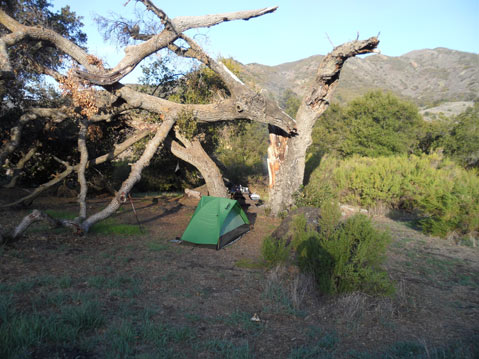Little Pine Mountain Easy Backpack
Search for the Sacred Springs

Name of Hike: Little Pine Mountain via 19 Oaks; the three springs
Mileage: 3.6 miles easy backpack; 10.4-mile day hike on second (middle) day
Suggested Time: 2.5 to 3.0 days (suitable for children who are accustomed to hiking and like to scramble around looking for water sources)
Map: B. Conant’s San Rafael Wilderness Trail Map Guide (2009 edition)
“Backpacking” bolsters one’s sense of autonomy, even when natural conditions drastically change the trail epic that had been the ego’s grand plan. On this easy, three-day backpack, plus a long day hike, I enjoyed two nights of tent-camping at verdant Nineteen Oaks Camp, a pastoral paradise depicted in a late-February column. The gnawing yen to cross over San Marcos Pass and rush out into the San Rafael Wilderness reminds us of the outlandishly beautiful spring flowers that display themselves all over the backcountry and frontcountry.

My original backcountry intention was a much longer backpack, heading up Little Pine Mountain on the Santa Cruz Trail, packing over Alexander Saddle to enchanting Little Pine Spring to get water, and continuing along the “40-Mile Wall” to Santa Cruz Camp: a grandiose 12-mile backpack from the truck.
Hiking solo, in my sixties, I keep thinking there has to be a way to ease the pressure on the knees and lower back. A 12-mile backpack over 4,450-foot Little Pine Mountain may be too much, especially jumping straight out of my truck and out of my urban life on Santa Barbara’s Westside. The sparse winter rains, under 8 inches for the rain year as of early March, have me worried about finding sufficient water en route. (More rain came later in March and in April, after this backpack.) I’m toting a bare minimum, 35 pounds, and refuse to haul several liters of water on the four-mile steady ascent from Nineteen Oaks to Alexander Saddle.
Looking for helpful signs, again poring over the Bryan Conant map, the blue squiggle for “spring” catches my attention, and I remember the potent spring of tasty water at good old Nineteen Oaks Camp. I’ll drive up Highway 154, turn right on Paradise Valley Road, cross the Santa Ynez River, and go to Upper Oso Camp where the pavement stops: The backpack starts here. However, I purposely leave late on a Sunday from Santa Barbara, because Nineteen Oaks Camp is just 1.7 hiking miles up the Romero-Camuesa Road. When you leave the dirt road (no cars) after 0.7 mile, you see the sign for the Santa Cruz Trail, and Nineteen Oaks is only one more mile.
Arriving at Nineteen Oaks in early evening after a one-hour warm-up backpack, I find the campsite deserted and even more beautiful than I’d remembered, and the copious spring slakes the thirst in wonderful fashion. After a fantastic night immersed in an ocean of silence, an important decision must be made, and there’s been time to reflect on this choice. I may have to refigure my proposition to get to Santa Cruz Camp: The misgivings center mostly around this aging body and the availability of dry wood, as well as water up on the mountain.
Nineteen Oaks Camp sits at the base of Little Pine Mountain, much of which was burnt in the 2007 Zaca Fire. The Santa Cruz Trail ascends brutally from Nineteen Oaks for over 2,200 feet during the ascent to Alexander Saddle (at 3,960 feet), and the trail quality is very poor in places. Mountain bikers have ruined long sections of this hiking trail, and horses have damaged it, too. Biking is unfortunately allowed up on the long frontside of Little Pine since the official “wilderness” designation only begins near Alexander Saddle at the top (San Rafael Wilderness allows no bikes).
My challenge on this backpack is to find good water along the 12 miles of the Santa Cruz Trail. Conant’s 2009 map shows three springs on Little Pine Mountain, and I do know where all of them are and have supped their holy fluids at one time or another. The first is here at Nineteen Oaks, and it not only flows abundantly but tastes like an elixir from higher times. There is some mystery about whether the other two springs higher up will be flowing on a very dry rain year.
Canadian philosopher Charles Taylor suggests that in our postmodern times, it’s very easy to miss those “signs” that may inform you about choices for your life’s direction. Taylor feels that “mechanism undermines enchantment,” and that we’ve lost a sense of eternal time or “eternity” (he calls it “higher times”). In A Secular Age he asks why so many Westerners are “disenchanted” with the cosmos. Why does their world feel so “flat” to them, as if it resides behind a screen? Among other deficits, Taylor mentions the general loss of “the understanding of things as signs or expressions of a higher reality.”
Taylor writes that wilderness “is not [only] the locus of an alternative life to the ‘city’… rather, it communicates or imparts something to us which awakens a power in us of living better where we are,” even in town.
Looking for clues and signs for the day-two adventure, I checked myself on the first morning at Nineteen Oaks and realized my lower back was very sore (despite ibuprofen), and the balky right knee felt funny and achy, too. After two minor surgeries on the knee joint, I can pretty much call the weather with it, and I notice if it’s unhappy. The downed wood and twigs were damp, and I’d used up three of my four small lighters trying to get a fire going the first morning. And then of course there was the uncertainty about finding water at the two remaining springs.
These signs led me to cancel the backpack to Santa Cruz Camp and reformulate the trip as “Quest for the Three Sacred Springs on Little Pine Mountain,” doing the difficult ascent as a day hike from Nineteen Oaks sans backpack.
During the pleasant ascent of Little Pine Mountain on day two — exceedingly delicious without the 35-pound backpack — fragrant and colorful flowers formed vast fields and took over my world. Enchanting prickly phlox and occasional Indian paintbrush flowers were set off by acres of deep purple lupine. The day was clear but beautifully blue out west toward Old Man Mountain, and not particularly warm on March 13. Slight breezes wafted sweet scent from masses of mountain wildflowers, and I saw swatches of orange and yellow amid the dominant purples and green. The western idea of time as an arrow —> evaporates with my sweat, and I fairly fly up the slope in a dream-time stupor, stopping now and then to moon over the frenzied flower fields above and below. The frantic bees, drunk on pollens and sunlight, buzz incessantly until this symphony is all I’m able to hear.
After climbing three miles you see the distinct turnoff up to the spring. By this one, Conant has “trough” — and darn, while the huge trough is full and horses will enjoy this refreshment, the white pipe directly from the spring above barely drips at all. It’s also hanging so low that it touches the trough’s scummy water surface, and when I lift the pipe gently the scant waterflow stops completely. Seven miles to Santa Cruz Camp, and I have one liter of water but hope the last spring, called Little Pine Spring, will be gushing.
In another mile I reach Alexander Pass, and here you can make a right (east) trail turn to go to the actual top of Little Pine or continue on, as I did, and begin a welcome one-mile descent looking for the third miracle water source. This tiny spring, and campsite with one rickety table, lies below Happy Hollow and about 0.3 mile down into an overgrown arroyo or gulch. The sign says one quarter-mile, but even using my hiking poles it was quite difficult clambering down there, and I only found the spring because I was here once 20 years ago or more. Long trousers, long-sleeved shirt, wide-brim hat, water, and safety gear essential for this. The beautiful camp spot will have horrendous insect hordes later this spring and into summer, and I’m now disappointed to discover the spring has already dried up, although the area is quite damp. I have read one guide claiming the spring here is “reliable,” but it is finished this year.
Little Pine Spring Camp is utterly wonderful and makes up for being so hard to find; I’m very scratched-up despite heavy clothing. Sometime in the late 19th century this area was the haunt of a sheep-herder named Florentine Garcia, who scrabbled together a primitive cabin here. He was part Yaqui and married the daughter of a well-known Chumash Indian, Jose Ignacio.
Eating lunch seated at the Little Pine Spring Camp table — Clif bar, tuna, bread, licorice — it strikes me that all the signs did point correctly to bagging the backpack to here (and for the next five miles to Santa Cruz Camp and the next water). Obviously, getting back up out of here to the trail proper will also be very demanding (it was), and to continue down the so-called “40-Mile Wall” five more water-less miles with this daypack seems daunting. I’m 5.2 miles in and will turn around and retreat to Nineteen Oaks.
I return up to Alexander Saddle and then descend easily back to Nineteen Oaks Camp for the second overnight. Still no people, even though the busy car-camping site at Upper Oso is less than two miles away. Despite my lighter problems, by sprinkling a few drops of my white gas onto the sticks I manage a decent fire the second night and refresh myself again and again from the spurting spring.
The loss of this enchantment-feeling, so carefully described by Taylor, leaves postmodern human too open to depression, fear, and pulling back into the gated community and the machine-mind. Yet it is in the wilderness that we sometimes find the dreamtime to reflect on what is actually happening. It is very hard work becoming even partially human, and it takes slow-time.
From the start, there were many signs and clues indicating a 12-mile backpack was a “bad idea,” including an innate caution after little mistakes — for example, I forgot firestarter materials. Yet, whenever one is ensconced in the wild, even less than two miles from the roadhead at Upper Oso, the chance for deeper reflection appears. Slow time — to ponder, to study the signs, to listen, and to rest the restless Western mind.
Undertaking frequent short trips into the low mountains of the Santa Barbara backcountry inspires one to work on re-enchanting his or her world. Slow down, Santa Barbaran. Returning, the pressures and craziness of Western civilization below threaten less, and memories of the dreamtime buoy one up.



